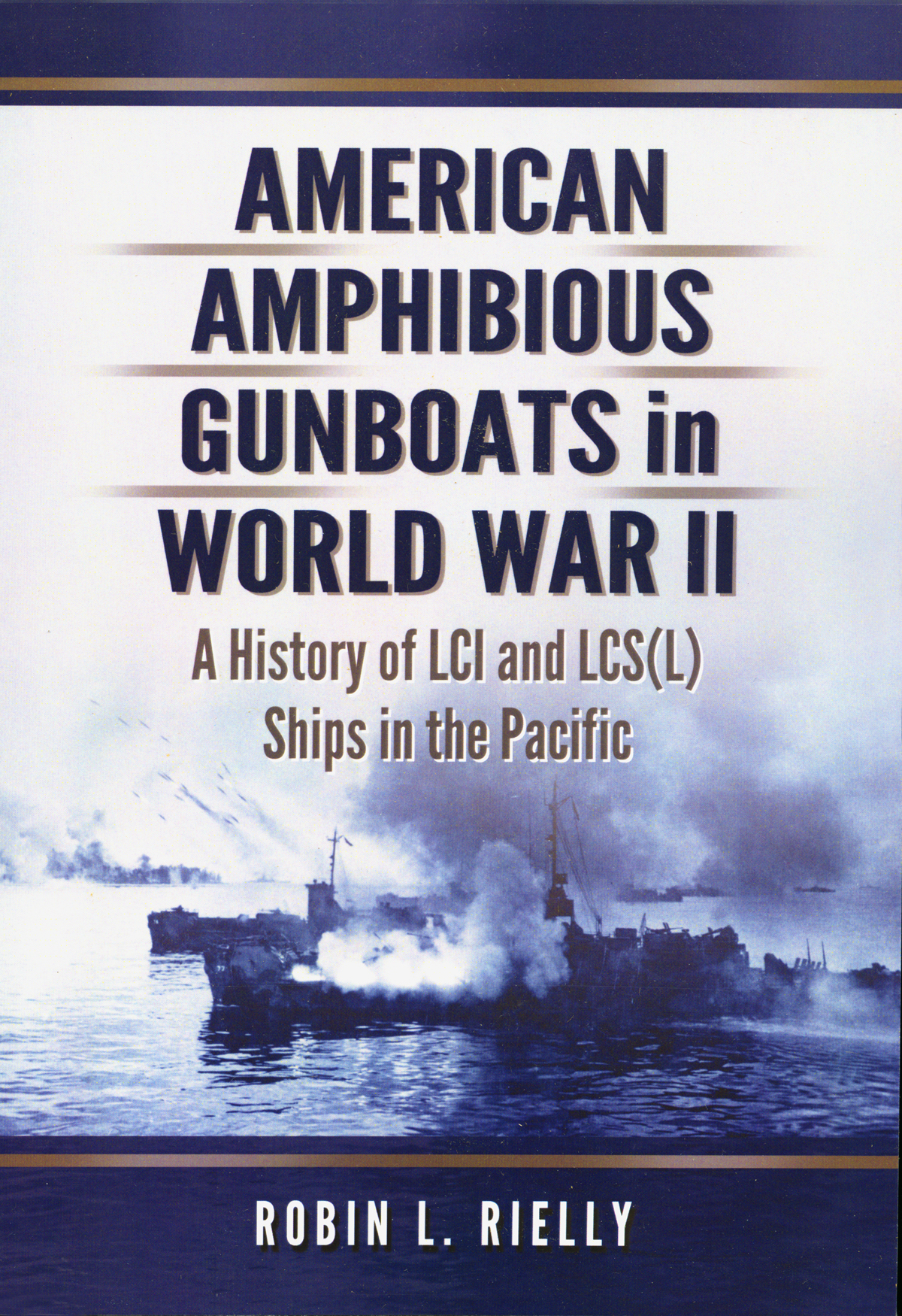![]()
![]()
Updated 6/11/2013
|
American Amphibious Gunboats in World War II: A History of the LCI and LCS(L) Ships in the Pacific
By Robin L. Rielly 408 pp. $45.00 McFarland & Company, Inc., Publishers
A review, By John Rooney Thoughts about that old war, the Big One, have grown dimmer with the years, but the big stories from it keep coming along. Historian Rob Rielly’s new book, AMERICAN AMPHIBIOUS GUNBOATS in WORLD WAR II, his fourth book about the war, is one. It is an extensive account of the inception, evolution and uses of the shoal-draft gunboat which became a major offensive component of the amphibious force during our island-hopping invasions and campaigns across the Pacific. Days before an invasion, the big boys, well seaward, would plaster the shoreline with heavy ordnance up to 16-inches. When the bombardment ended, some armed enemy survivors were able to appear from pillboxes, revetments, foxholes and caves to offer lethal resistance against landing troops, and later, those moving into the island. Given the hard lesson of Tarawa in 1943 - 1,800 Marines, Navy and Army killed - the Navy brass knew they had to have many more ships with strong firepower working close to the beach to strengthen landing preparation and assist our ground forces fighting their way inland. A klaxon call went out to the Amphibs, and the era of the small, powerful gunboat began. The pug-nosed 158-foot LCI(L), Landing Craft, Infantry was flat-bottomed, could make up to 14 knots safely in shoal water, and, with heavy deckloads of guns, rockets, mortars and ammunition, would remain open-ocean seaworthy with sufficient ballast. She was selected as the basic hull platform for the four main gunboat types: LCI(G), LCI(R), LCI(M) and LCS(L). The first conversion was the LCI(G), used to intercept and destroy enemy barge traffic operating in shallow water big ships couldn’t enter. It was armed with an ear-shattering 3”/50 in the bow, 40mm, 20mm and .50 caliber guns, and used in the Solomon Islands. It was very effective, and many more LCIs were soon converted to LCI(G)s and employed on beach assault in landings to put heavy gunfire on pillboxes and guns ashore before troops hit the beach. Various armament configurations were used on LCI(G)s, and some acquired rocket launchers as well. They stood guard near underwater demolition teams preparing a beach approach for invasion, led invasion runs into a beach, destroyed enemy barges and targets of opportunity, defended against aircraft, protected anchorages against suicide boats and swimmers, and made smoke to cover anchored big ships from air and surface attack. LCI(R)s carried a deck full of rack-mounted barrage rockets, good for hitting a beach during the slack time between heavy shore bombardment and the landing of troops, when enemy defenders were likely to appear on the beach. They carried 4.5 inch fin-stabilized rockets with a 1,200-foot range and a 300 foot barrage depth, and later 5 inch spin-stabilized rockets with a 5,000 foot range. Rockets were a devastating weapon, clearing large areas of a beach, and giving the small LCI(R) the firepower of a capital ship. LCI(M)s carried three 4.2 inch mortars with a range of 3,200 yards, longer than the short, 4.2 inch fin-stabilized rockets, and were more destructive. With their parabolic flight mortars were able to reach far into the littoral and behind mountains. They were also very effective, in spite of lost time repairing damaged mounts from the mortar’s kickback, and the tricky helm work sometimes required to keep a flat-bottomed hove-to ship from wandering in a seaway while pointing at a fixed target ashore. LCS(L)s joined the gunboat flotillas in the last year of the war. Heavily armed like the LCI(G), they mounted ten rocket launchers, four 20 mm astride the conning tower and deckhouse, and various bow-gun configurations of the 3’’/50, single or twin 40mm, a few .50 caliber machine guns along the rails, and a twin 40 near the stern. Early ones were used to support troop landings in Borneo and in the Phlippines off Corregidor, where they lost three ships to suicide boat attacks. In fleet anchorages they laid smoke for the big ships and fought suicide boats and swimmers. They accompanied destroyers on the hazardous radar picket line off Okinawa with anti-aircraft support, firefighting, damage control and recovery and treatment of wounded. Those posted for the radar picket line had their single 40 mm “Army job” in the bow replaced by a fire-directed twin 40 if available, better for anti-aircraft work. Their performance against kamikaze aircraft earned LCS(L)s the nickname of Mighty Midget. Deeply researched and wide-ranging, this history has 356 pages of text, a glossary, five indexes of flotilla makeup, ship damage and awards, voluminous chapter notes, a bibliography of sources and an extensive alphabetic index, making it an excellent reference work. Throughout the narrative many tense actions are detailed, in official reports, and often personalized with oral accounts from combatants. Pictures throughout are of high quality and illustrations are legible and informative. All in all, this is a complete, definitive account of the gunboats of World War II and their contributions. This well-wrought story of the gunboats shows them to be a most vital and successful component of the amphibious force in all the island campaigns, from the Solomons on, including the Philippines, Iwo and Okinawa. Neither sleek nor swift, each of the LCI-spawned gunboat variants showed its unique value, and produced a memorable record of versatility and effectiveness. What these powerful little ships and their sailors did is well worth learning about – and honoring. |
